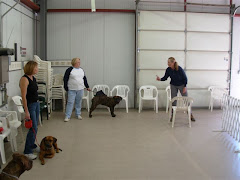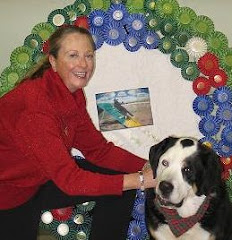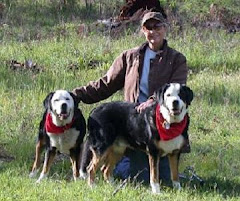 Years ago in Yakima, my husband and I started dog-sitting for friends and favorite Manning Dog Training students who were going out of town for a few days and didn't want to commercially kennel their dogs. Word spread, and before we knew it we were booked solid with overnight canine guests. It was like having a doggy slumber party every night in our house. With our own four dogs, we frequently had up to six hairy kids running around our house, clogging up the hallways, crowding the doors, and carpeting our floors. It was crazy, and it was great fun.
Years ago in Yakima, my husband and I started dog-sitting for friends and favorite Manning Dog Training students who were going out of town for a few days and didn't want to commercially kennel their dogs. Word spread, and before we knew it we were booked solid with overnight canine guests. It was like having a doggy slumber party every night in our house. With our own four dogs, we frequently had up to six hairy kids running around our house, clogging up the hallways, crowding the doors, and carpeting our floors. It was crazy, and it was great fun.Our dog-sitting service was so popular that it got out of hand. The revolving door and related stress was affecting the quality of our own dogs' lives, so we scaled back...and encouraged our friend Laurie Mosher to take our overflow. She eventually launched her own Yakima business, K-9 Country Club, one of the nicest boarding facilities in Washington. Her place is exceedingly popular!
Now here we are in retirement, in Montana, with two dogs of our own....and a guest dog lying at my feet. His name is Jack. He's a mellow yellow Lab. Here we go again! (Not.) Really, it's a pleasure to take Jack so his parents (friends of ours) can have a few days of vacation. We like Jack, and would much rather he stay with us, in a real home, than go to a typical (non-K-9 Country Club) commercial boarding kennel.
Jack came with his list of warnings..."He'll hike his leg on everything....he may not eat for a day or more....he might run if you let him loose outside..." and we shrugged and said, "No problem, he'll be fine."
And he has been fine, primarily because we haven't given him the opportunity to mess up. Whether it's a new puppy of our own, or an adult dog we know quite well, they all start out the same way:
1. No excessive coddling when their parents leave them and drive away. The guest dog instantly becomes treated like one of our pack, which he has just become.
2. A drag leash goes on the dog's collar immediately. If he has a properly fitting chain-type training collar, we prefer to use that first because it communicates more quickly to the dog. The drag leash goes on the "live" ring of the choke chain when the dog is under supervision. We may remove the choke chain in a day or so if it's not needed, and we always fasten the two rings together for safety when the dogs are playing. If the chain collar doesn't fit snugly, we remove it because it's too big a hazard for dogs playing together.
3. Immediately, we teach or do refresher training on "Curb," which is a boundary training especially useful at doors. We don't just use it to keep the dog from bolting out a door; we use it also to demonstrate our leadership from the very beginning. It's a good reminder because we use it at every door, indoors and out.
4. The dog initially is supervised--observed--100% of the time. This gives us the chance to correct for any thoughts of leg-lifting or snarliness. It lets us give the dog a crash course in manners required in our household. And, if the dog isn't sure of the potty rules, we can show him where to go when he begins to ask. Supervision may last only a few hours, or it could last for several days, depending on the temperament and maturity of the dog.
 5. Any unsupervised time is spent in a crate. We have several large crates stationed around our house. We use them like playpens for babies--a safe place to contain them when you just don't have time to watch them every second.
5. Any unsupervised time is spent in a crate. We have several large crates stationed around our house. We use them like playpens for babies--a safe place to contain them when you just don't have time to watch them every second.6. Meals come twice a day, on schedule. If the dog chooses not to eat at 6am and 6pm, he waits until his next opportunity 12 hours later. He's hungry by then.
7. Outside time: we have a securely fenced back yard. Our guest dogs never go outside the fenced yard unless then are on leashes, with us holding the other ends. No sense taking chances with potential runaways.
8. ID tags: we check the collar tags when the guest dog arrives. We generally add a temporary tag to the dog's collar. That tag will have our name, address and phone number on it. If the dog gets loose, we want his finders to call us, rather than having to track down his owners vacationing somewhere in Mexico.
9. Bedtime: all dogs go out for one last potty before shuffling off to bed or crates. Everyone sleeps together in the master bedroom. Guest dogs sleep in a crate, at least for the first few nights.
After about three days, the guest dog usually knows the routine and is happy and relaxed living in our home with our own dogs, because it's become his home too. He has assimilated into the pack; he knows the rules and, more importantly, the routine.
Jack goes home tomorrow. We'll miss him! Tonight he's sleeping outside the crate. He's still wearing a drag leash, but it's more for Angus (our Lab) to tug on than anything else. Jack's taken up some ownership of our home; he barks low and deep if he sees elk in the yard, or if he hears something strange outside. We allow him to wander throughout the house on his own now; he has earned our trust.
Caring for someone else's dog in your own home is pretty pleasant if you follow the rules, treating every dog as if it's a 10-week-old unhousebroken puppy for the first few days. Do the groundwork first, even if it's just refresher training, and you set the dog--and yourself--up for success.


















2 comments:
If I could only get the grandparents to follow these rules with kids!! :) Funny how well kids do if they were given these same rules! (With a few modifications!)
Wow! What a great post.I just found this blog. I'll definitely be back. Professional Pet Sitter
Post a Comment